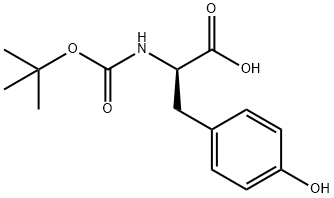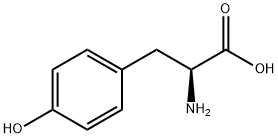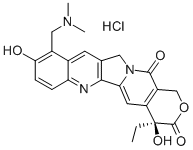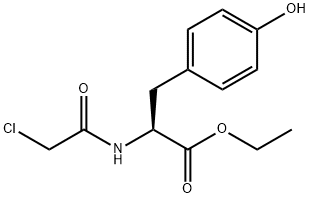L-Tyrosine hydrochloride
Synonym(s):3-(4-Hydroxyphenyl)-L -alanine;3-(4-Hydroxyphenyl)-L -alanine hydrochloride
- CAS NO.:16870-43-2
- Empirical Formula: C9H12ClNO3
- Molecular Weight: 217.65
- MDL number: MFCD00012617
- EINECS: 628-139-8
- SAFETY DATA SHEET (SDS)
- Update Date: 2022-12-21 16:56:50

What is L-Tyrosine hydrochloride?
Chemical properties
White to off-white crystalline powder
The Uses of L-Tyrosine hydrochloride
L-Tyrosine Hydrochloride is the salt form of L-Tyrosine (T899975), is one of the 22 proteinogenic amino acids that are used by cells to synthesize proteins. L-Tyrosine is biologically converted from L-phenylalanine and is in turn is converted to L-DOPA and further converted into the neurotransmitters such as dopamine, norepinephrine, and epinephrine.
What are the applications of Application
L-Tyrosine hydrochloride is the HCl salt of tyrosine - a precursor to catecholamines
General Description
Tyrosine is a polar, non-essential amino acid with a phenolic functionality. L-tyrosine is a natural amino acid that is incorporated into proteins as directed by the genetic code. The phenolic function makes the tyrosine residue in proteins a principle recipient of reactions such as phosphorylation/dephosphorylation important for cell signalling. Tyrosine is also a precursor of various neurotransmitters and hormones.
Biochem/physiol Actions
Tyrosine is a nonessential amino acid found in mammal, fish and birds. It participates in protein modification, such as phosphorylation, nitrosation and sulfation. It is involved in immune response regulation and prevents the generation of inflammatory cytokines and superoxide. Tyrosine serves as a precursor for epinephrine, norepinephrine, dopamine, thyroid hormones and melanin biosynthesis. Tyrosine phosphorylation is associated with a number of cellular processes such as cell proliferation and migration, development of the embryo, cellular metabolism and transcription. Tyrosine phosphorylation also aids activation of the enzymatic function of a protein.
Properties of L-Tyrosine hydrochloride
| Melting point: | 239 °C (dec.)(lit.) |
| storage temp. | 2-8°C |
| CAS DataBase Reference | 16870-43-2(CAS DataBase Reference) |
Safety information for L-Tyrosine hydrochloride
| Signal word | Warning |
| Pictogram(s) |
 Exclamation Mark Irritant GHS07 |
| GHS Hazard Statements |
H315:Skin corrosion/irritation H319:Serious eye damage/eye irritation H335:Specific target organ toxicity, single exposure;Respiratory tract irritation |
| Precautionary Statement Codes |
P261:Avoid breathing dust/fume/gas/mist/vapours/spray. P264:Wash hands thoroughly after handling. P264:Wash skin thouroughly after handling. P271:Use only outdoors or in a well-ventilated area. P280:Wear protective gloves/protective clothing/eye protection/face protection. P302+P352:IF ON SKIN: wash with plenty of soap and water. P305+P351+P338:IF IN EYES: Rinse cautiously with water for several minutes. Remove contact lenses, if present and easy to do. Continuerinsing. |
Computed Descriptors for L-Tyrosine hydrochloride
New Products
4-Fluorophenylacetic acid 4-Methylphenylacetic acid N-Boc-D-alaninol N-BOC-D/L-ALANINOL Tert-butyl bis(2-chloroethyl)carbamate 3-Morpholino-1-(4-nitrophenyl)-5,6-dihydropyridin- 2(1H)-one Furan-2,5-Dicarboxylic Acid Tropic acid S-2-CHLORO PROPIONIC ACID ETHYL ISOCYANOACETATE 2-Bromo-1,3-Bis(Dimethylamino)Trimethinium Hexafluorophosphate (6-METHYL-[1,3]DITHIOLO[4,5-b]QUINOXALIN-2-ONE INDAZOLE-3-CARBOXYLIC ACID 4-IODO BENZOIC ACID (2-Hydroxyphenyl)acetonitrile 4-Bromopyrazole 5,6-Dimethoxyindanone 2-(Cyanocyclohexyl)acetic acid 4-methoxy-3,5-dinitropyridine 2-aminopropyl benzoate hydrochloride 1-(4-(aminomethyl)benzyl)urea hydrochloride diethyl 2-(2-((tertbutoxycarbonyl)amino) ethyl)malonate tert-butyl 4- (ureidomethyl)benzylcarbamate Ethyl-2-chloro((4-methoxyphenyl)hydrazono)acetateRelated products of tetrahydrofuran








You may like
-
 L-Tyrosine Hydrochloride CAS 16870-43-2View Details
L-Tyrosine Hydrochloride CAS 16870-43-2View Details
16870-43-2 -
 L-Tyrosine CAS 16870-43-2View Details
L-Tyrosine CAS 16870-43-2View Details
16870-43-2 -
 1975-50-4 98%View Details
1975-50-4 98%View Details
1975-50-4 -
 2-HYDROXY BENZYL ALCOHOL 98%View Details
2-HYDROXY BENZYL ALCOHOL 98%View Details
90-01-7 -
 2-Chloro-1,3-Bis(Dimethylamino)Trimethinium Hexafluorophosphate 221615-75-4 98%View Details
2-Chloro-1,3-Bis(Dimethylamino)Trimethinium Hexafluorophosphate 221615-75-4 98%View Details
221615-75-4 -
 61397-56-6 CIS BROMO BENZOATE 98%View Details
61397-56-6 CIS BROMO BENZOATE 98%View Details
61397-56-6 -
 14714-50-2 (2-Hydroxyphenyl)acetonitrile 98+View Details
14714-50-2 (2-Hydroxyphenyl)acetonitrile 98+View Details
14714-50-2 -
 118753-70-1 98+View Details
118753-70-1 98+View Details
118753-70-1